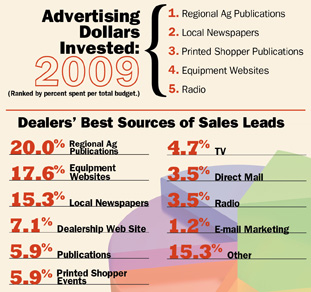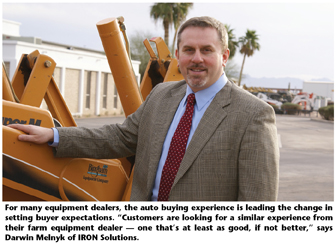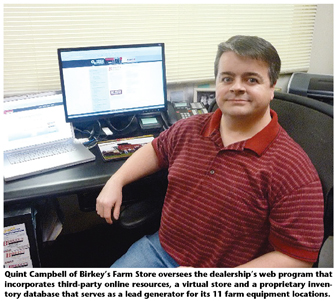New software and web-based tools are making the auto-dealer model a reality — and turning dealer web sites into another store location.
In today’s challenging economy, farm equipment dealers agree — it’s more important than ever to spend their marketing dollars wisely. To move ahead of the competition, many are focusing on online initiatives that can renew customer relationships and give prospects a reason to do business with them.
Farm Equipment interviewed a number of leaders in the rapidly changing field of online equipment marketing and came away with several key strategies that could give dealerships a boost in 2010.
Without question, the Internet has profoundly impacted how customers interact with dealerships. This is especially true at the early stages of a customer relationship. But it wasn’t long ago that setting up a highly functional web site was both frustrating and costly. Some dealers simply opted for online classifieds, while others ignored online opportunities altogether.
The fact is the Internet presents real opportunities for sales growth. And setting up a dealer web site, complete with lead-generating capabilities, is no longer the Herculean task that it once was. Dealers can now take advantage of the latest technology to develop sales-driven web sites, complete with search functionality, rich content, online and offline advertising integration, lead generator and social networking.
One of the pioneers in the field of online farm equipment sales is IRON Solutions of Fenton, Mo. IRON Solutions, which provides a wide range of data, software and online marketing solutions to the farm and construction industries, has spent the last several years benchmarking the digital explosion, and growing along with it.
According to IRON Solutions’ CEO Darwin Melnyk, the promise of streamlining lead generation at the farm equipment dealer level is very real. “Our company has worked hard to expand our services for the farm equipment industry,” says Melnyk. “The bottom-line goal is to drive more sales opportunities into sales departments.”
Tapping the Automotive Experience
IRON Solutions is benchmarking the auto industry and for good reason. The typical auto dealership sells to consumers, commercial businesses and other dealers. Each type of sale has a different dynamic. But in all cases, auto dealers have set a new standard for the online customer experience.
According to a 2008 report by the National Automotive Dealers Assn. (NADA), 88% percent of car buyers conducted research before walking into a dealership; 83% used the Internet to conduct vehicle research, and 79% researched auto dealers for used inventory.
In terms of used car sales, Kelly Blue Book reported that in 2003, 39% of buyers found their cars on dealer’s lots, while only 19% found their cars online. By 2007, 37% of buyers found their cars online and the number of buyers sourcing cars from dealer lots had dropped to 27%.
On the marketing side, things are changing, too. NADA reports that the average cost a dealership pays in traditional marketing costs to sell a new vehicle is $610. That compares with an average of just $302 in Internet marketing costs.
Another study from the National Assn. of Manufacturers (NAM) shows that industrial manufacturers are moving quickly from traditional to online marketing methods, with customer acquisition and lead-generation activities topping the list of priorities for 2010.
From these studies, Melnyk observes that, “Manufacturers are trying to spend their dollars more efficiently to create leads and acquire customers. They’re using tools like online directories, web sites and newsletters because they can measure the effectiveness of their spend, and find out if their activities are driving leads back to a dealer.”
The statistics speak volumes. Auto dealers and manufacturers appreciate the efficiency of the Internet and its ability to close the loop on where they spend their marketing dollars. And consumers can find what they’re looking for online, saving both time and money.
Digital Marketing of Ag Equipment
Sweeping changes in the way automobiles are marketed have created new consumer expectations and behaviors across all sectors. Customers now come to their farm equipment dealers with a sense of how they want to be engaged and do business.
“If I’m a farmer and I buy a $45,000 truck from the General Motors dealership in my town, I tend to look for that same experience when buying a $150,000 piece of equipment from my farm equipment dealer,” says Melnyk. “Keep in mind that this farmer has likely purchased several cars or trucks since his last farm equipment purchase. So the bar has already been set.”
For many equipment dealers, the auto buying experience is leading the change in setting buyer expectations. “Customers are looking for a similar experience from their farm equipment dealer — one that’s at least as good if not better,” says Melnyk.
So make no mistake, these changes are coming to the farm equipment sector. In fact, many of the marketing tactics in use today by auto dealerships are quickly being adopted by farm equipment dealerships across North America. “It’s definitely a trend that reflects where the industry is headed,” says Melnyk.
Fastline Facts
Don Durs, marketing manager for Buckner, Ky.-based Fastline, says when it comes time to shop and buy used equipment, farmers are flocking to the Internet. “Buyers go there because they understand they can competitively shop for equipment, and it’s convenient.”
Durs adds that most farm equipment dealers today have some type of online presence — and those who don’t are missing out on the opportunity to sell their equipment to a much broader audience. “The majority of our 3,000 or so customers are equipment dealers who appreciate and understand where their audience is going,” he says. “They’re often surprised to learn just how easy it is to get their equipment online, and how much of a reaction they can get in terms of responses and trackable leads.”
Fastline recently hosted a forum with a number of farm equipment dealers to better understand how dealers want to promote their equipment to customers and other dealers. “A lot of the conversation was about the Internet,” he notes. “The customer is a lot more educated. They go to the Internet to understand the product they’re looking for, to price the equipment and features and to see what’s available. Dealers are now building their marketing around that.”
Technology: No Obstacle
So how will dealers make the next technological leap from simply posting online ads to hosting highly functional web sites that offer sophisticated lead-generation capabilities?
For many, the solutions will come from the latest on-demand software — web-based applications that can eliminate the need for site developers and back-office server components. The emergence of on-demand software has dramatically reduced web site costs. Today, these services are widely available, along with online training and support.
“The software that successfully drives more business to your dealership is as simple to use as any online application,” notes Melnyk. “And the days of expensive and complicated software are over. A lot of dealers are using on-demand software to take advantage of these opportunities.” (See “The Power of Online Lead Generation” in adjacent sidebar.)
From Melnyk’s perspective, acquiring the tools and infrastructure for an online presence is no longer a cost issue for most farm equipment dealers. Melnyk also debunks the notion that dealers need to hire information technology specialists to manage their online activities. The limitations, if any, are more likely to stem from a lack of dedicated personnel to manage the site and its activities once the virtual store is up and running.
Melnyk likens the dealer’s web site to an additional store location, but one that is virtual. As such, an experienced sales and marketing support team that’s focused on the customer should back the dealer’s virtual store.
“Find a champion who is half marketer, half seller,” he advises. “I know of dealerships that generate more than $1 million in online sales, simply because they treat their online activities like a separate store, and they have the staff for it.”
The Virtual Store
A dealership’s web site is a central component of any successful online sales and marketing program. So what should dealers put on their sites, and how can they leverage their online activities to drive more traffic and, ultimately, sales?
Online equipment buyers most frequently look for used equipment and the dealers who sell it, according to Melnyk. This explains why dealers are placing so much emphasis on advertising used inventory online. Searches for used equipment can generate far more sales leads when compared with new. For dealers, this information becomes an important asset.
In addition to used equipment, buyers are increasingly looking to search, build, compare and view new equipment. The ability to perform these functions is rapidly emerging with the online product configurators now available from several equipment manufacturers. These online tools create new opportunities for sales leads, but dealers need to work closely with the manufacturer’s representatives to make sure they receive all incoming leads. Dealers also need to respond quickly to incoming customer inquiries. In the auto industry, inquiries typically will receive a response within hours.
After checking out the products, customers and prospects tend to seek more information about the dealer: how to contact, location, hours and directions. This is where first impressions really count. People will often decide whether they want to do business with a dealer based on the look of its site and business description. Everybody wants their physical stores to look sharp. The same holds true for virtual stores.
The more serious customers then move on to next level. They may request a quote, ask about trade-in values, apply for financing or view special promotions or incentives. This is an opportunity for dealers to engage the customer in a sales dialogue.
Equipment customers also routinely access dealer sites to find parts and accessories and schedule service. “I’ve seen dealers who do an excellent job of scheduling services in the off months,” says Melnyk. “They can get those machines in and out of the shop, using their web site for customers to schedule service, and tying that to someone in the service department. That’s a real winner for dealers to increase service revenue.”
Birkey’s: A Turnkey Solution
Quint Campbell, marketing manager for Birkey’s Farm Store, based in Rantoul, Ill., has been involved in the dealership’s web initiatives for the last 11 years. Today the Case IH and New Holland dealership has a robust web program that incorporates third-party online resources, a virtual store and a proprietary inventory database that serves as a lead generator for its 11 farm equipment locations.
The focus of Birkey’s online activities is used equipment inventory. The dealership advertises its entire used inventory online, using its own web site as the primary tool for selling used equipment. To further its reach, the firm also exports the used equipment data to a number of third-party providers.
“There’s still a need for print, but the majority of our customers are now going to the web sites first,” says Campbell. “We’re shifting to online advertising and updating our web sites daily, so the information is always current.”
For tracking sales and inventory, the dealership relies on an internal database site that’s accessible to the sales team, so they can add, update and mark units sold. The inventory database also captures important information about each sale, such as where a product was sold and the type of lead that generated the sale.
A full-time Birkey’s employee dedicates half of his time to maintaining the two sites, but the benefits are well worth it. “Nearly 20% of our used equipment sales now come from online sources,” says Campbell. “The internal site has been up for about a year now and our salesmen love it. All of the critical information is in a database that we can access and that we control.”
Campbell also closely tracks those online leads that result in sales. For example, if an inquiry generates an email to the store manager, he’ll ask to be kept in the loop. “I want to see where we should spend our ad dollars,” he says.
“From 2008 to 2009, the online leads that resulted in sales shot up 57%. That’s a pretty good jump, so this year we’ll be increasing our budget with more online advertising.”
To further promote the web site, Birkey’s has also tapped a few social media outlets in recent months. “We use these to promote our web site, and as a way for search engines to get our name out there,” says Campbell. “Besides direct traffic, the majority of our visitors are coming from search engines, so we’re trying to increase our page visibility and ranking on the search engines by using a blog, Facebook and Twitter.”
Vacin: Surprising Sales Results
Michael Lynch, sales manager for Vacin Inc., based in Clarkson, Neb., agrees that when it comes to selling used equipment, online is the way to go. Vacin takes a basic approach that’s backed by strong sales and marketing support.
“We’re reducing our print budget considerably on used equipment,” he notes. “Other than local word of mouth, we put ads on our own web site or on sites like JD Express, Fastline and Tractor House. That’s where the customer leads are coming from.”
Not surprisingly, this John Deere dealership, with locations in Clarkson and Humphrey, Neb., makes it a priority to post used equipment online and remove units sold. Ads include detailed product descriptions with multiple photos that feature the equipment from all angles, including a shot of the machine’s hour meter to verify usage. “We take a very detail-oriented approach,” says Lynch. “If we post a lot of quality pictures that show detail, we’ll get calls.”
Lynch especially appreciates the speed and flexibility of selling online. “Because we can update the information instantly, we’ll get calls right away,” he says. “This fall, because the corn was wet, people decided they needed better combines or second combines. It gives us the ability to move with the market and the seasons.”
Thanks to the Internet, the dealership’s geographic reach is far greater today than it was just 3 years ago. Last winter, for example, a sod farmer in Rhode Island contacted the Nebraska dealership. “He was looking to buy used JD 8000 tractors and he bought two tractors from us,” says Lynch. “This year the same customer, who now has a relationship with us, decided to plant corn and needed a combine, a corn head and a grain bin. He bought it all from us. Without the web, that never would have happened.”
The dealership’s regional scope has expanded as well. “Today we routinely sell late-model used tractors within 200 miles of here,” says Lynch. “If you can’t sell used, you can’t sell new. So I’m excited about it.”
Focus on Fundamentals
Once a virtual store is open for business, the initial challenge for dealerships is to drive visitors to the site. Then it’s a matter of encouraging those customers to contact the dealership.
“Get people to call by offering attractively priced used equipment that is well presented,” advises Melnyk. “Do the best you can to market your used piece. It’s one of your best lead generators. Even if a unit doesn’t meet the customer’s requirements, you’ve got a good lead you can track down the road.”
As with any good lead generator, it’s essential to have systems in place for handling incoming queries and tracking leads.
“When a piece of equipment is on the web site, that dealer is going to get phone calls,” says Durs. “We’re bringing the dealers leads. When customers want more information, you get a phone call or an e-mail, and you can track those calls and e-mails.”
Regardless of whether dealers are leveraging existing online resources, hosting a virtual storefront or both, the most critical success factor is the dealer’s ability to engage online customers when they visit.
“When the Internet rings, be sure to answer it,” says Melnyk. “Your customers are coming to your online store with expectations. Your response is the electronic equivalent of a handshake and a business card.”
The Power of Online Lead Generation
Businesses no longer need design and build their virtual stores from the ground up. Instead of buying costly servers and software, and hiring teams of designers and technicians to build and maintain their web sites, many firms now take advantage of web-based solutions that offer businesses powerful new site functionality.
For many, the solutions start with the latest on-demand software — web-based software applications that can eliminate the need for site developers and back-office server components. Training and setup is typically included. Upgrades are generally provided during the subscription term, and no technical skills are required.
It’s like renting your virtual storefront instead of having to build it from the foundation up.
While the specific capabilities of different web sites will vary, the goal is always the same — to convert potential clients into real customers. Best of all, anyone with basic computing skills can use today’s technology to convert online activities into sales.
Take the prospective customer who visits an Internet site for the first time. How can the site encourage that visitor to become a customer?
Any good sales clerk knows that customer behaviors can prompt dialogue. Customers who seem overwhelmed are generally responsive when asked: “Can I help you find something?” Likewise, by keeping close tabs on the activities of site visitors, online systems are able to prompt questions and help customers find information.
For example, visitors who are serious about buying a specific product will conduct additional research about that product. Each time visitors dig deeper for specific information, the system accumulates data and begins to recognize them as potential buyers who are interested in learning more about the business and its offerings.
At this point, the site may take action: a popup window may appear, asking visitors if they’d like a call from a customer service representative. If yes, the dialogue continues and the system prompts the visitor for contact details. And if a visitor provides his contact information, the chances of converting that prospect into a customer are very good.
In just a few keystrokes, the interaction has moved from the anonymity of the web to a personal phone call. Now it’s up to the sales staff to engage the prospect, seek more information and convert this Internet surfer into a new customer.
Site Search: Online Options Abound
Dealers agree: when it comes to selling used equipment, online is the way to go. But where should dealers go to sell their used machinery?
Below is a short list of independent sites that are helping equipment dealers nationwide quickly turn their used inventory into profitable sales:
- AgDeal.com
- agriculturalwebservices.ovom
- equipmentlocator.com
- EquipmentTraderOnline.com
- FastLine.com
- IronPlanet.com
- IronSearch.com
- IronWeb.com
- TractorHouse.com
- TractorsAndFarming.com
- TractorSearch.com
- UsedFarmEquipment.net
- USfarmer.com
In addition to the independents, the major ag equipment manufacturers offer used online sales and service options for their dealers. Together, these online marketing sites are proving to be an effective way to generate used equipment sales — and new sales leads.
Farm Equipment Dealership Marketing Mix Survey Results: How Do You Measure Up?
Farm Equipment commissioned an online survey of dealership marketing managers in late 2009. Following is a sampling of data provided by respondents. Average Annual Advertising Budget Respondents to the survey spent an average of $113,896.35 on advertising in 2009.
A Disconnect in Investment vs. Results. Radio, TV, Events and Direct Mail all command a proportionately higher advertising investment than results indicate, report dealers.
Marketing’s Dark Horse. While dealers generally investing the most in other marketing mix components, the dealership’s own website is among the best generator of sales leads.
Confidence Lacking. When asked how confident marketing managers are in purchasing the right mix of advertising for their dealership, the median answer was only 5.1 on a scale of 1-10 (1=least confident, 10=most confident).
The Biggest Trend
Write-in responses by dealers indicate a definite movement toward more Internet advertising during the last 3 years.
Social Media: Only Scratching the Surface. Social Media is only beginning to take hold in farm equipment dealerships’ marketing plans. In order, the most popular sites are Facebook, YouTube and Twitter.

For a complete copy of the marketing mix dealer survey, email mlessiter@lesspub.com









Post a comment
Report Abusive Comment